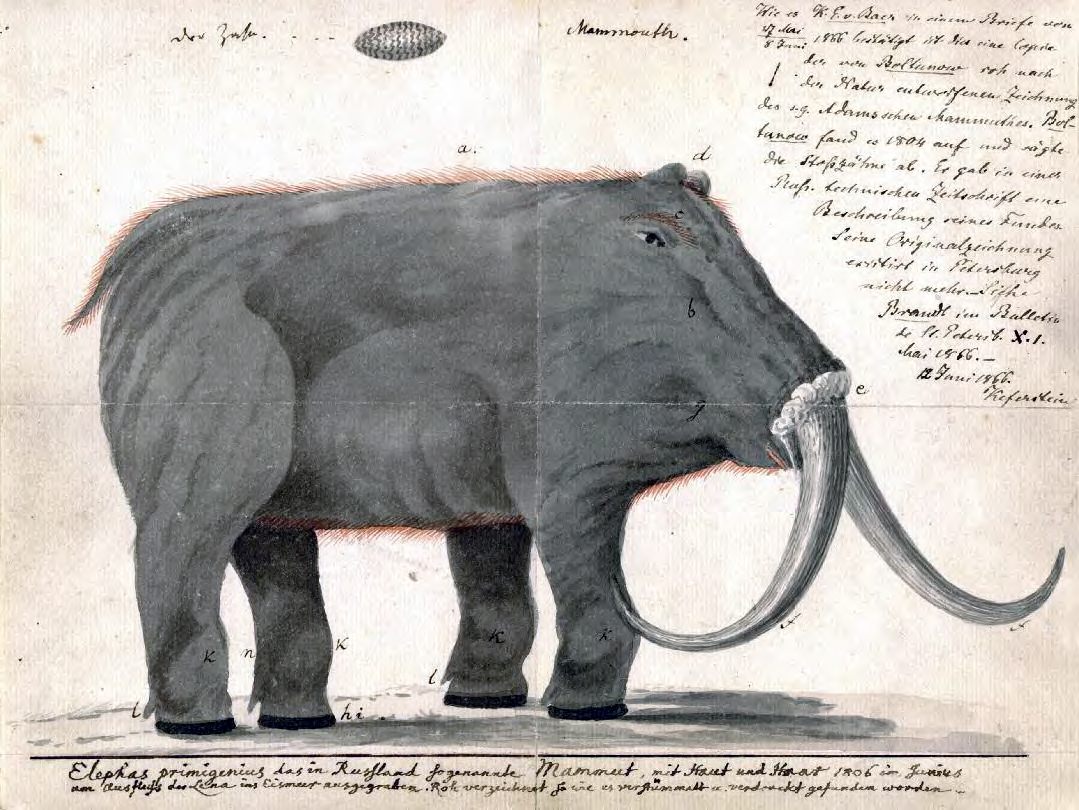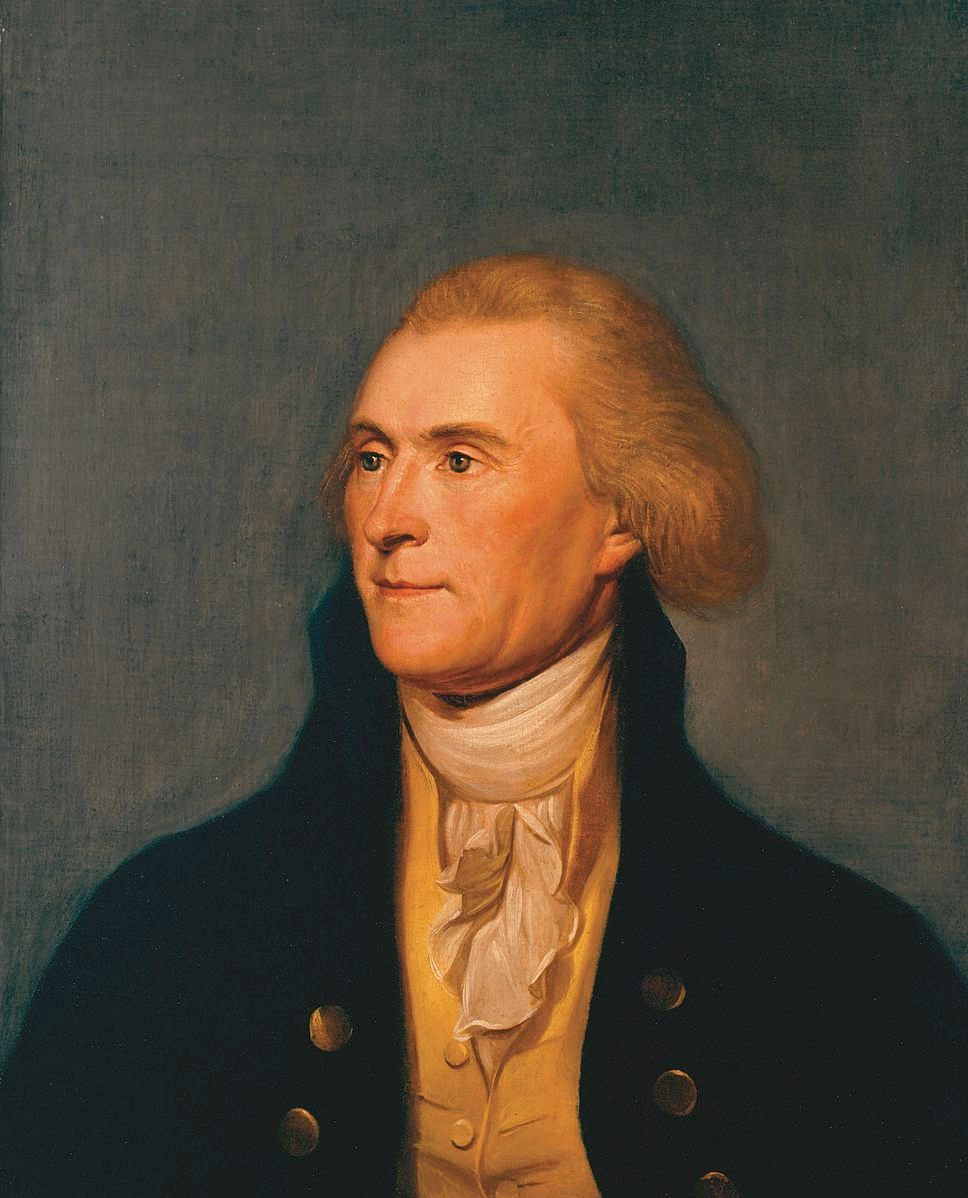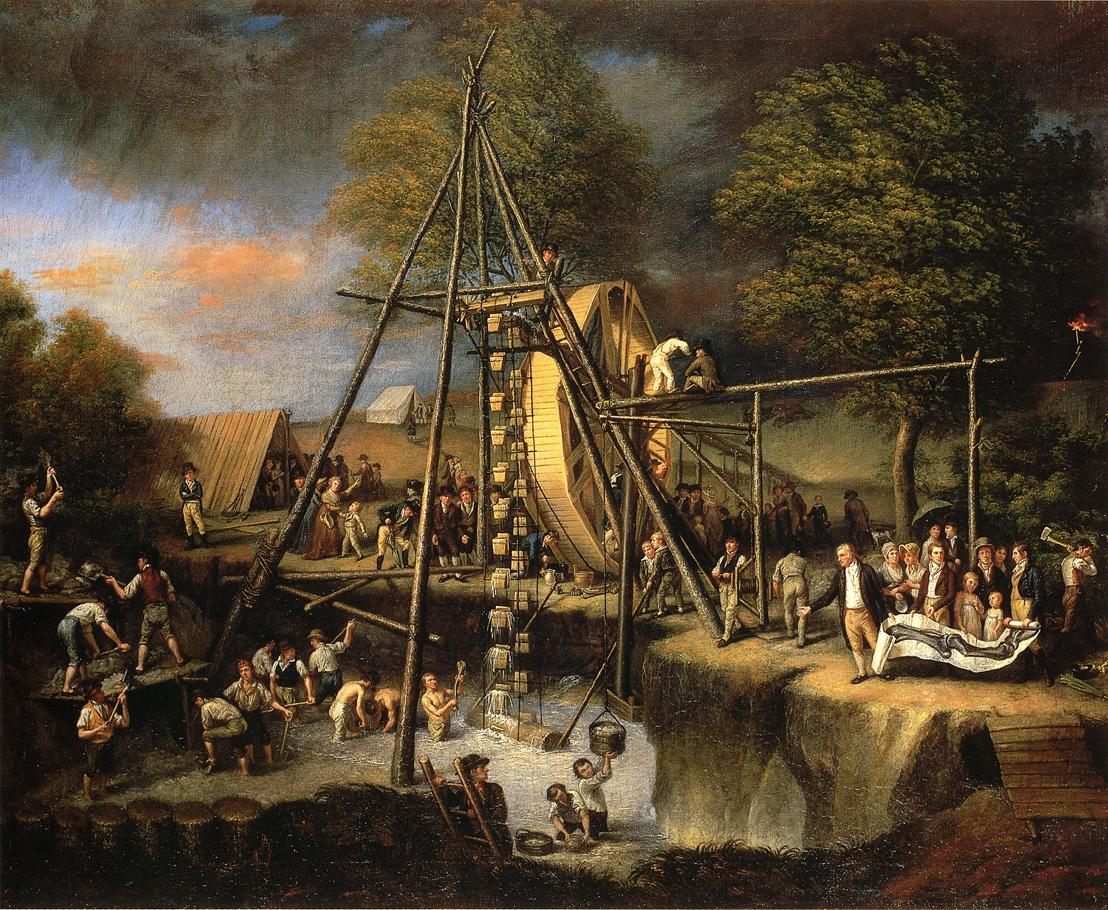Thomas Jefferson Built This Country On Mastodons

Drawing of an early 19th century attempt at a mammoth restoration. Note the upside-down tusks. (Image: WikiCommons/Public Domain)
On July 4th, 1776, Thomas Jefferson had a lot on his mind. At 33, he was the youngest Virginia delegate at the Second Continental Congress. The War of Independence was raging all around him, and its resolution would either see him helping to lead a brand new nation or dragged back into a monarchical regime he detested. And now the greatest minds of all the thirteen American colonies were poring over his draft of the Declaration of Independence, preparing to vote on whether to make his vision a reality. It was a full day.
However, the odds are pretty good that somewhere underneath that powdered wig, Jefferson was also thinking about mammoths.
For most of his life, Thomas Jefferson was obsessed with mammoths. (More correctly, he was obsessed with American mastodons, tree-chewing cousins of mammoths that lived in the Northern part of the continent—but at the time, he and the rest of the world thought they were mammoths.) He liked theorizing about mammoths, he liked talking about mammoths, he liked making his friends rack up exorbitant postage bills in order to mail him mammoth teeth. And for decades, from the mid-1760s onward, he was particularly dedicated to one surprisingly high-stakes activity—convincing a famous French naturalist that mammoths were still out there, tearing up the wild West with their tusks.

Jefferson, painted in 1791 by Charles Wilson Peale, maybe with mammoths on the mind. (Image: WikiCommons/Public Domain)
Jefferson liked science more than he liked politics. He was a fastidious vegetable breeder and weather recorder, he led the American Philosophical Society for eighteen years, and he once spent a while re-engineering the plow according to Newtonian principals. He particularly loved fossils, and collected and speculated on them so avidly that he is considered “the founder of North American paleontology,” says Dr. Mark Barrow, an environmental history professor at Virginia Tech.
Like the rest of the country, he was particularly enamored with one huge, mysterious type of fossil—the seven-foot tusks and crate-sized jawbones that kept being dragged out of American salt licks and riverbeds. Mammoths and mastodons roamed the United States for millions of years, and when they went extinct at the end of the Pleistocene, they left plenty of forensic evidence behind. They first stampeded into the colonial imagination in 1705, when a tenant farmer in New York came across a molar “the size of a man’s fist.” This “tooth of a Giant” was sold, traded, and gifted around until it was famous on both sides of the ocean, and everyone was talking about the huge, mysterious “incognitum,” or “unknowable,” that had dropped its bones all over the continent and disappeared.
The incognitum slowly became more knowable, thanks partially to efforts of Jefferson and other big fans, who sent bits of it overseas to European scientists who could compare them to similar fossils. Experts debated whether it was a gentle grazer, or a terrifying carnivore capable of “mighty leaps.”
But for Jefferson, the mammoth and its particulars were more than just scientific curiosities. As the Minutemen took on King George’s army, Jefferson was in the middle of a quieter war. He, too, was fighting for the future of his nation, but it was more of a rhetorical fight—one he couldn’t win with blood. So he decided to try bones instead—huge bones; bones that would show America’s adversaries what the young country was really made of.

“Exhuming the First American Mastodon” by Charles Wilson Peale, painted in 1806. (Image: WikiCommons/Public Domain)
Jefferson’s nemesis was a famous Frenchman with a double-tusked name: George Louis Leclerc, comte de Buffon. Buffon was an established writer, naturalist, and public intellectual, and he spent the second half of his life working doggedly at a 46-volume series called Histoire naturelle. The sprawling megabook contains deep dives into 400 different types of birds and mammals, along with treatises on topics ranging from nutrition to animal domestication, and a new theory of the origin of the Earth (it, and the rest of the solar system, splintered off when a comet crashed into the sun). None of it bent Jefferson’s ear—until Volume V, published in 1766, in which Buffon proposed his aptly titled “Theory of American Degeneracy.”
In this volume, Buffon took on what was, to him, a fundamental question: why are American animals so much worse than animals from the rest of the world? Buffon had never actually been to America—he was relying on secondhand accounts from early explorers. Still, he put forth his data with great certainty: “No American animal can be compared with the elephant, the rhinoceros, the hippopotamus, the dromedary, the camelopard [giraffe], the buffalo, the lion, the tiger, &c,” he wrote.
Of the species that the continents shared, American ones were inevitably lesser—bears were smaller, stag had shorter antlers, and wolves had less impressive tails. People native to America were inherently worse, too, and Europeans and domesticated animals who traveled from the Old World to the New actually degenerated once they got there—their blood got “watery,” and their bark and bite dwindled. Meanwhile, the reptiles and insects were diverse and enormous! Why could that be?

Pages from Buffon’s Histoire naturelle. (Photo: Benj89/WikiCommons CC BY 3.0)
Buffon couldn’t have come up with a better way to piss off Jefferson if he had tried. But that wasn’t his goal— the budding American statesman wasn’t even on Buffon’s radar. He was too focused on taking down his own greatest rival: Carl Linnaeus, inventor of taxonomy.
Buffon thought Linnaeus was ruining ecology. He hated how his focus on cataloguing the planet’s every creature had taken the discipline down a road of nitpicky classification, completely skipping broader questions about how the creatures had gotten their characteristics in the first place. “There are not in the whole habitable earth above two hundred species of animals,” Buffon wrote, “even including forty different species of monkeys,” and in his opinion, it was time to stop subdividing them and start figuring out how they got to be the way they were. In Buffon’s mind, “what makes American animals so terrible?” was exactly the type of question a natural historian should ask.
 G.L.L. Comte de Buffon takes a rare break to pose for a portrait. (Image: Wellcome Images CC BY 4.0)
G.L.L. Comte de Buffon takes a rare break to pose for a portrait. (Image: Wellcome Images CC BY 4.0)
The answer was, somehow, worse than the question—Buffon’s theory was that America was too cold and wet to prosper. Due to wind patterns and untrammeled wilderness, the sun only provided enough warmth and nourishment to make “cold men and feeble animals.” Animals who had migrated from the Old to the New became so corrupted by all the “wallowing in mire” that they shrunk, weakened, or disappeared entirely. Meanwhile, the Old World remained sunny and prodigious, and its species were full of spit and vinegar. This theory was, literally, an attack on American soil.
It quickly became a problem for America. Not only were Buffon’s ideas insulting, they were frighteningly popular: his book was a bestseller, “read by virtually every educated person in Europe,” the very same people America relied on for money, political support, and new recruits. At the time, many European hobbyist naturalists were also aristocrats, and they took Buffon’s theory as scientific proof for their own anti-egalitarian stance. The Theory of American Degeneracy was trotted out not only to explain why America’s deer were smaller and dogs were quieter, but to prove that the whole American experiment was doomed to fail. The climate just wasn’t right for democracy.
This drove Jefferson crazy. Disproving Buffon became, according to biologist Lee Alan Dugatkin, “one of his great obsessions”—even as he wrote the Declaration, governed Virginia, saw the War of Independence won, served as the minister to France, and suffered the death of his wife and several of his children. Over the course of several years, as author Jon Mooallem describes in Wild Ones, Jefferson amassed his case against Buffon. He made the other Founding Fathers measure animal carcasses and send him their findings. He brought an American panther skin across the ocean with him to France and dropped it at Buffon’s place. He then tried to one-up himself by mounting a campaign to get a moose stuffed and sent over, a years-long ordeal that ended with a partially putrified specimen shedding on Buffon’s doorstep, the wrong type of antlers tied to its head.
 An 1807 letter from Jefferson to General George Rogers Clark, asking him to help ship some mammoth bones to Washington. (Image: Library of Congress Public Domain)
An 1807 letter from Jefferson to General George Rogers Clark, asking him to help ship some mammoth bones to Washington. (Image: Library of Congress Public Domain)
So when a different Frenchman finally and inadvertently gave Jefferson a chance to attack Buffon publicly, he jumped on it. In 1780, the Secretary of the French Delegation asked him a few dozen questions about Virginia for a survey France was doing on the United States. In response, Jefferson holed up in his vacation home in Poplar Forest and churned out what would eventually become a full-length book, Notes on the State of Virginia, in which he described everything he knew about his state, along with his deepest convictions about what makes for a good society.
He also took the opportunity to stick it to Buffon from all sides. He argued for the humanity of the Native Americans, and reprinted a speech by Chief Logan of the Shawnees that became much admired in Europe. He carefully compiled more accurate temperature data to show that America, too, can get downright toasty, and he listed New World geniuses, including Washington (a genius “in war”), Franklin (physics), and vaunted astronomer David Rittenhouse.
But his trump card was his chart of animal sizes, compiled from his patient correspondents’ measurements and topped by his beloved mammoth.
 The beginning of Jefferson’s animal size comparison chart. (Image: Thomas Jefferson/APS)
The beginning of Jefferson’s animal size comparison chart. (Image: Thomas Jefferson/APS)
The chart is preceded by a chapter detailing all kinds of fossil discoveries, and marshaling painstaking evidence that the remains indeed belonged to mammoths and not, as some Europeans had claimed, hippos and elephants that had died next to each other. These pages are full of the type of Jeffersonian rhetorical heft also present in the Declaration: a Native American chief asked to describe the mammoth “immediately put himself into an attitude of oratory… suited to what he conceived the elevation of his subject,” and Jefferson calls the hippo/elephant theory “remarkable” in its ignorance.
He parries Buffon’s claims directly in the stirring conclusion: “The truth is, that a Pigmy and a Patagonian, a Mouse and a Mammoth, derive their dimensions from the same nutritive juices… what intermediate station they shall take may depend on soil, on climate, on food, on a careful choice of breeders. But all the manna of heaven would never raise the mouse to the bulk of the mammoth.” If there are mammoths, the Americans must not be mice.
Of course, this line of argument depends on there actually being mammoths. Without these chart-toppers, Jefferson was stuck waxing poetic about hedgehogs and comparing the weights of European and American beavers. Jefferson addresses this with another deft rhetorical maneuver: the “why not?”
“It may be asked, why I insert the mammoth, as if it still existed? I ask in return, why I should omit it, as if it did not exist?…[the north and west] still remain in their aboriginal state, unexplored and undisturbed by us, or by others for us. He may as well exist there now, as he did formerly where we find his bones.”
Buffon’s works eventually made room for the mammoth, and for its impressiveness, if not its survival: “The prodigious mammouth [sic], whose enormous bones I have often viewed with astonishment, and which were, at least, six times larger than those of the largest elephant, has now no existence.” And Jefferson’s various gambits to get him to back down further—the pitiful moose, for example, and his even less successful attempt to find a live mammoth to clinch the point—didn’t inspire Buffon to pick up his pen again before he died in 1788.
As the 18th century waned, claims of American degeneracy and other Old World criticisms lost their claws. Jefferson’s contemporaries met some head-on—Benjamin Franklin successfully stopped a conversation about Buffon’s theory in a room full of tall Americans and short Frenchmen by telling everyone to stand up. As America built on its triumphs and tragedies, and developed narratives of its own, the rest just faded out.

Jefferson also tried to make a case that these bones belonged to a giant American lion. They are actually from a prehistoric ground sloth, which now bears his name: Megalonyx jeffersonii. (Image: Caspar Wistar 1799/APS Transactions, vol. 4 (old series)
But even after Buffon’s death, Jefferson couldn’t give up the mammoth hunt. He was motivated now by something more fundamental than revenge—he, like many of his contemporaries, didn’t think animals even went extinct, least of all ones as impressive as mammoths. It interrupted his view of nature as a Great Chain of Being, held together by a design in which “no link… [is] so weak as to be broken.” In the early decades of the 19th century, another upstart French naturalist, Georges Cuvier, convinced the world that extinction was not just possible, but common. Even without that, the shrinking frontier didn’t leave many places for huge fauna; as Barrow says, “Westerners had explored much of the globe, and mammoths just didn’t seem to be around.”
Meanwhile, Jefferson gave spare teeth to his friends, and served on the American Philosophical Society’s Bone Committee, whose goal was to “procure one or more entire skeletons of the Mammoth.” A decade later, as president, he used federal money to achieve that goal, and spent his downtime puzzling the bones together on the floor of the White House. And when he sent Lewis and Clark to the Louisiana Territory, he asked them to keep an eye out for a live one.
In reality, of course, there weren’t any. In fact, some experts think that early humans hunted them to death, making mammoths the first entry on a different chart: that of animals killed off by people. But conviction, patriotism, and loyalty sometimes outmuscle truth. Soon before his death, Jefferson wrote to John Adams, and said he could accept that “certain races of animals are become extinct.” But he never mentioned the mammoth.

An American Mastodon skeleton, displayed in the National Museum of Science and Nature in Tokyo. (Photo: Momotarou2012/WikiCommons CC BY 3.0)
Intentionally or not, Jefferson littered American history with mammoth bones. So this Fourth of July, take a minute to dwell on his beloved incognitum—everything it lets us believe in, and everything it blocks from our view.
Naturecultures is a weekly column that explores the changing relationships between humanity and wilder things. Have something you want covered (or uncovered)? Send tips to cara@atlasobscura.com.




















Follow us on Twitter to get the latest on the world's hidden wonders.
Like us on Facebook to get the latest on the world's hidden wonders.
Follow us on Twitter Like us on Facebook